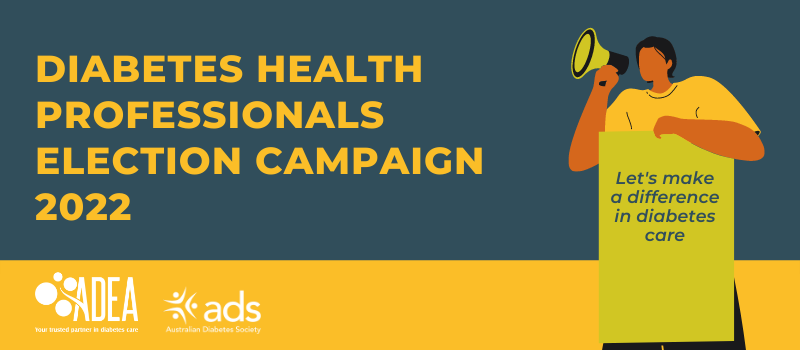Already a member? Click here to login.

Australian Diabetes Educators Association
Already a member? Click here to login.

Already a member? Click here to login.

This election year, we want Parliament to make a real difference to the 1.4 million Australians living with diabetes and their carers.
In 2022, Parliament has the chance to drastically improve the lives of Australians living with diabetes, strengthen the health system, prevent and reduce disease burden and save money long-term by improving access to health care providers. In Australia, people living with diabetes shouldn’t lack access to expert diabetes care.
There are three small changes that health providers agree would have a tremendous impact:
Diabetes technology is lifesaving and improves the lives of thousands of Australians living with diabetes. However, learning how to use this technology can be challenging. Endocrinologists and Credentialled Diabetes Educators (CDEs) equip their patients and clients with the education and advice they need to manage diabetes technology.
To ensure their patients and clients receive the necessary care, they often work out of clinic hours and pro-bono, answering urgent calls or replying to text messages. In many cases, their intervention can prevent a late-night trip to the emergency department or even hospitalisation.
58,000 Australians are eligible to access crucial and often lifesaving diabetes technology through NDSS funding. Let’s ensure they understand how to use the technology optimally by supporting them with expert diabetes care. MBS funding for diabetes technology initiation and support will decrease inequity and increase access to the health system.
The National Diabetes Services Scheme (NDSS) annual cycle of care recommends that a person living with diabetes receive between four and up to 17 allied health visits a year to maintain optimum health, manage diabetes, and lower the risk of diabetes-related complications which include heart attacks, stroke kidney failure, blindness, and foot amputations. Five visits a year for allied health and five reserved for CDE visits for the population at increased risk, at a GP’s discretion, will help people living with diabetes access the care they require to manage their condition well and may reduce the risk of diabetes-related complications.
Data demonstrate that people who develop gestational diabetes in pregnancy have an increased risk of developing type 2 diabetes, so do children born to parents who had gestational diabetes. Data demonstrate that half of all people with gestational diabetes will develop type 2 diabetes.[1] To reduce risk and provide continuity of care, all people diagnosed with gestational diabetes should be provided with MBS-reimbursed referrals to a visit a CDE:
This is in addition to the existing MBS referral to an Endocrinologist.
For further information about the Diabetes Health Professionals Election Campaign 2022, please reach out to:
Melanie Gray Morris
Manager Policy, Advocacy & Communications
email: melanie.morris@adea.com.au
[1] Lowe, et al. (2018) Association of Gestational Diabetes with Glucose Metabolism and Childhood Adiposity. JAMA, 320(10): 1005-1016. doi:10.1001/jama.2018.11628.

This election year, we want Parliament to make a real difference to the 1.4 million Australians living with diabetes and their carers.
In 2022, Parliament has the chance to drastically improve the lives of Australians living with diabetes, strengthen the health system, prevent and reduce disease burden and save money long-term by improving access to health care providers. In Australia, people living with diabetes shouldn’t lack access to expert diabetes care.
There are three small changes that health providers agree would have a tremendous impact:
Diabetes technology is lifesaving and improves the lives of thousands of Australians living with diabetes. However, learning how to use this technology can be challenging. Endocrinologists and Credentialled Diabetes Educators (CDEs) equip their patients and clients with the education and advice they need to manage diabetes technology.
To ensure their patients and clients receive the necessary care, they often work out of clinic hours and pro-bono, answering urgent calls or replying to text messages. In many cases, their intervention can prevent a late-night trip to the emergency department or even hospitalisation.
58,000 Australians are eligible to access crucial and often lifesaving diabetes technology through NDSS funding. Let’s ensure they understand how to use the technology optimally by supporting them with expert diabetes care. MBS funding for diabetes technology initiation and support will decrease inequity and increase access to the health system.
The National Diabetes Services Scheme (NDSS) annual cycle of care recommends that a person living with diabetes receive between four and up to 17 allied health visits a year to maintain optimum health, manage diabetes, and lower the risk of diabetes-related complications which include heart attacks, stroke kidney failure, blindness, and foot amputations. Five visits a year for allied health and five reserved for CDE visits for the population at increased risk, at a GP’s discretion, will help people living with diabetes access the care they require to manage their condition well and may reduce the risk of diabetes-related complications.
Data demonstrate that people who develop gestational diabetes in pregnancy have an increased risk of developing type 2 diabetes, so do children born to parents who had gestational diabetes. Data demonstrate that half of all people with gestational diabetes will develop type 2 diabetes.[1] To reduce risk and provide continuity of care, all people diagnosed with gestational diabetes should be provided with MBS-reimbursed referrals to a visit a CDE:
This is in addition to the existing MBS referral to an Endocrinologist.
For further information about the Diabetes Health Professionals Election Campaign 2022, please reach out to:
Melanie Gray Morris
Manager Policy, Advocacy & Communications
email: melanie.morris@adea.com.au
[1] Lowe, et al. (2018) Association of Gestational Diabetes with Glucose Metabolism and Childhood Adiposity. JAMA, 320(10): 1005-1016. doi:10.1001/jama.2018.11628.